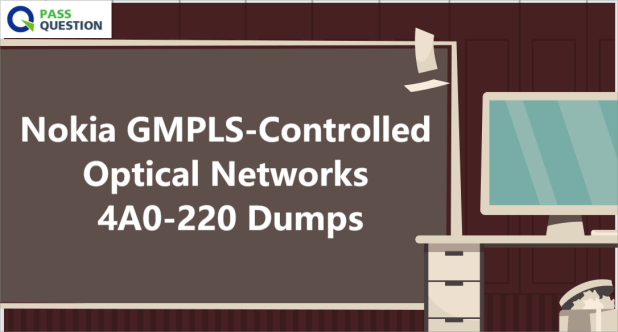Nokia GMPLS-Controlled Optical Networks 4A0-220 Dumps
To ensure that you are fully prepared for the 4A0-220 Nokia GMPLS-controlled Optical Networks Exam, PassQuestion provides the latest Nokia GMPLS-Controlled Optical Networks 4A0-220 Dumps which cover all the exam objectives and provide you with the necessary knowledge and skills to successfully pass your exam with ease. With our Nokia GMPLS-Controlled Optical Networks 4A0-220 Dumps, you can confidently approach the exam knowing that you have covered all the essential topics and have a solid understanding of the subject matter. By studying our 4A0-220 Dumps, you will not only gain the theoretical knowledge needed for the exam but also develop the practical skills required to excel in your future career.

Nokia GMPLS-controlled Optical Networks Exam
The Nokia GMPLS-controlled Optical Networks Exam is designed to provide participants with a comprehensive understanding of the skills and knowledge necessary to effectively control and manage optical networks. Through this exam, participants will have the opportunity to explore and gain familiarity with the Nokia GMPLS routing engine implementation (GMRE) and the Network Functions Manager for Transport (NFM-T). By mastering these tools, participants will be equipped to confidently perform provisioning and restoration tasks in optical networks, ensuring seamless operation and maintenance.
Exam Details
Exam name: Nokia GMPLS-controlled Optical Networks
Exam number: 4A0-220
Mandatory prerequisites: none
Exam duration: 90 Minutes
Exam appointment duration: 110 minutes. This is the exam duration plus a 20-minute introductory survey.
Number of questions: 40
Language: English
Price: $125 US
Exam Modules
Module 1 – GMPLS CP Concept and Architecture
Module 2 – GMPLS Protocols
Module 3 – Protection and Restoration
Module 4 – GMPLS Maintenance and Operations
Study Tips To Pass Nokia GMPLS-Controlled Optical Networks 4A0-220 Exam
Here are some study tips to help you pass the Nokia GMPLS-Controlled Optical Networks 4A0-220 Exam:
1. Familiarize yourself with the Nokia GMPLS routing engine implementation (GMRE) and the Network Functions Manager for Transport (NFM-T). These tools are crucial for controlling and managing optical networks.
2. Understand the concepts and principles of GMPLS-controlled optical networks, including provisioning and restoration tasks. Make sure you have a solid grasp of how to effectively control and manage these networks.
3. Practice hands-on tasks related to provisioning and restoration in optical networks. This will help you gain practical experience and confidence in performing these tasks during the exam.
4. Review the exam objectives and ensure that you have covered all the necessary topics. Pay attention to areas where you may need additional study and practice.
5. Utilize available study resources, such as official Nokia documentation, practice exams, and online forums. Engage in discussions with other participants or professionals in the field to gain insights and clarify any doubts.
View Online Nokia GMPLS-Controlled Optical Networks 4A0-220 Free Questions
1. What is the Feasibility File in GMRE nodes?
A.A file with commissioned GMRE nodes for NPA implementation
B.A file of optical impairment parameters for power balance
C.A file with target values that determine whether a given LSP can be routed
D.A control checklist for the operator
Answer: C
2. Which of the following information is present in every GMPLS-enabled node?
A.The bandwidth of each client path in the entire network
B.The frequency of each client path in the entire network
C.The state of each link in the entire network
D.The list of LSPs created in the entire network
Answer: C
3. How do you add a 3R resource to the NPA in NFM-T?
A.The 3R is added in the Node panel and automatically added to the NPA
B.The 3R is added to the NPA through the Constraint Wizard
C.The resource is discovered automatically
D.The trail is provisioned with 3R constraints and discovered automatically
Answer: B
4. What is the purpose of the RSVP-TE Notify message?
A.It is the node's alarm control channel
B.It is a mechanism to inform the NM5 of L5P events
C.It is a mechanism to inform non-adjacent nodes of LSP events
D.It is confirmation of a node's resource reservation
Answer: C
5. Which categories of protocols are included in the GMPLS technology?
A.Signaling, routing, and forwarding
B.Link management, signaling, and switching
C.Routing, grooming, and signaling
D.Routing, signaling, and link management
Answer: D
6. When should two physical connections belong to the same SRG?
A.When one is the protection of the other
B.When they share the same risk of failure
C.When they are both selected during the setup process
D.When they are fully disjoint respective to the risk of failure
Answer: B
7. Which of the following is not a key feature of GMPLS?
A.Self-discovery
B.Fast protection
C.Restoration
D.Resource optimization
Answer: D
8. Which provisioning steps are common in both CP to plain MP networks?
A. SRG creation Node synchronization CPB power balance
B. CPB provisioning process Link association CPB power balance
C.CPB provisioning process Node synchronization CPB power balance
D. CPB provisioning process Node synchronization NPA implementation
Answer: C
- TOP 50 Exam Questions
-
Exam
All copyrights reserved 2026 PassQuestion NETWORK CO.,LIMITED. All Rights Reserved.

